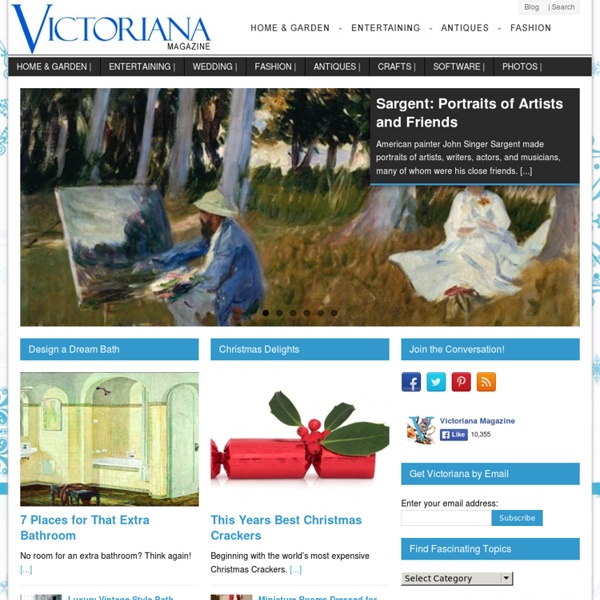



THE SEWING DIVAS sewing, design, fashion Front porch spindles, railing, balusters, wood rail, exterior balustrade - Western Spindle Main Site Menu, Step back into an age of paradox and power; The Victorian age was not one, not single, or simple. avictorian.com AVictorian Home La Belle Époque Art Nouveau Bourbon's Big Easy New Orleans Storyville District LaPorcherie Memphis, Elvis & BBQ Magnolias & Live Oaks The Old South Our graphics, owner's Mission Statement and presentation are all copyright protected; invasion of this privacy (by Plagiarism, using source HTML, and/or images/graphics will result in legal action. Mashallah Design, Linda Kostowski: Альтер-эго из джерси | Acciuga.ru Кажется, мир окончательно вступил в XXI век. Нет, отсчет нового тысячелетия начался десять лет назад, но мыслить цифровыми категориями в духе виртуальной логики мы начинаем только сейчас, во всяком случае, в сферах, которые касаются моды. Вчера вряд ли кому пришло в голову отсканировать собственное тело и его трехмерную модель скрестить с образами, рожденными в подсознании, с воспоминаниями или фантазиями, чтобы затем превратить все это в футболки. А сегодня, пожалуйста. Дизайн-дуэт Mashllah Design и любительница часов-обманок Линда Костовски (Linda Kostowki), можно сказать, проходят соучастниками по делу о футболках «T-Shirts Issue // Digital Portraits». Трудно определить, кому из них пришла идея совершить этот маленький переворот в швейном деле, но местячковая революция удалась на славу. Как известно, 3-D фигуры состоят из множества многоугольников, причем их число определяет разрешение модели, в той же степени в какой количество пикселей влияет на качество растровой графики.
The Philadelphia Shutter Company - Interior and exterior wood shutters for historical accuracy Sylwia Zientek FANTASMAGORIA szkice o artystach | "Nikt nigdy nie powstrzyma nas od interesowania się życiem genialnego człowieka. Można by powiedzieć, że on sam jest dziełem sztuki, że życie jego jest poematem czy powieścią, że on sam jest cudem." T. Boy
TEXTILE FUTURES | Central Saint Martins College MA Textile Futures Welcome to Our Victorian House final fashion Old House Restoration Stories & Blogs Have you ever wondered what it's like to restore an old house? Welcome to our archive of old house blogs and restoration stories. Do you maintain an old house blog? Arkansas The Devil Queen Crow Mountain, Arkansas Chronicles how my wife and I sold our souls to an 1890 Queen Anne Victorian. Web Site: View listing... California Casa Decrepit Alamdea, California Casa Decrepit - The restoration of the Italianate style home is simply amazing and the story reads better than any Reality TV Show. Web Site: casadecrepit.com/ View listing... Eureka Redwood Victorian Eureka, California Our House - A 1890s one and a half story with cross gable dormers - All redwood construction - walls, floor, & ceilings. Web Site: www.eurekavic.blogspot.com View listing... Vernacular Italianate in the Wine Country Healdsburg, California A vernacular Italianate in downtown Healdsburg California that has not been lived in for 60 years. Web Site: www.227northstreet.com/ View listing... Colorado
Rags and Mags — haute on the hog Airgas - Blasting Ice Airgas Blasting Ice What is Dry Ice Cleaning? Cleaning with Dry Ice is Clean and Safe. Dry ice cleaning (also known as dry ice blasting, dry ice blast cleaning, and dry ice dusting) is similar to sand blasting, plastic bead blasting, or soda blasting where a medium is accelerated in a pressurized air stream to impact a surface to be cleaned or prepared. But that's where the similarity ends. Instead of using hard abrasive media to grind on a surface (and damage it), Dry ice cleaning uses soft dry ice, accelerated at supersonic speeds, and creates mini-explosions on the surface to lift the undesirable item off the underlying substrate. Dry ice cleaning has many unique and superior benefits over traditional blasting media. Dry ice cleaning uses compressed air to accelerate frozen carbon dioxide (CO2) "dry ice" pellets to a high velocity. Carbon dioxide (CO2)is a non-poisonous, liquefied gas, which is both inexpensive and easily stored at work sites.